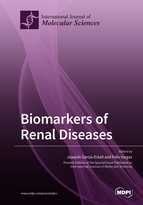Biomarkers of Renal Diseases
A special issue of International Journal of Molecular Sciences (ISSN 1422-0067). This special issue belongs to the section "Molecular Pathology, Diagnostics, and Therapeutics".
Deadline for manuscript submissions: closed (30 June 2020) | Viewed by 70182
Special Issue Editors
Interests: kidney; nitric oxide; calcium signaling
Special Issues, Collections and Topics in MDPI journals
Interests: kidney; aminopeptidases; arterial hypertension; nitric oxide
Special Issues, Collections and Topics in MDPI journals
Special Issue Information
Dear Colleagues,
The NIH Biomarkers Definitions Group has defined a biomarker as: “A characteristic that is objectively measured and evaluated as an indicator of normal biologic processes, pathogenic processes, or pharmacologic responses to a therapeutic intervention.” For acute or chronic kidney diseases, the ideal biomarker should show, among others, rapid and reliable changes with the progression of disease and be highly sensitive and specific, able to detect injury to the different segments of the nephron, and rapidly and easily measurable. Creatinine, for instance, is not a good renal marker since acute injuries would not show changes in filtration rate until the progression of disease allows its accumulation. Similarly, in chronic renal disease, the elevation in serum creatinine is a late indicator of the reduction in glomerular filtration. Other conventional biomarkers such as proteinuria, cell cylinders, and fractional excretion of sodium have shown lack of sensitivity and specificity for the early recognition of acute kidney injury, hence leading to the need and the enormous interest that arouses the possibility of using other biomarkers with the ability to perform early detection, differential diagnosis, assessment prognostic, response to treatment, and functional recovery. In this Special Issue, we welcome reviews or experimental papers showing significant advances in the field of renal biomarkers.
Prof. Dr. Joaquín García-Estañ
Prof. Dr. Felix Vargas
Guest Editors
Manuscript Submission Information
Manuscripts should be submitted online at www.mdpi.com by registering and logging in to this website. Once you are registered, click here to go to the submission form. Manuscripts can be submitted until the deadline. All submissions that pass pre-check are peer-reviewed. Accepted papers will be published continuously in the journal (as soon as accepted) and will be listed together on the special issue website. Research articles, review articles as well as short communications are invited. For planned papers, a title and short abstract (about 100 words) can be sent to the Editorial Office for announcement on this website.
Submitted manuscripts should not have been published previously, nor be under consideration for publication elsewhere (except conference proceedings papers). All manuscripts are thoroughly refereed through a single-blind peer-review process. A guide for authors and other relevant information for submission of manuscripts is available on the Instructions for Authors page. International Journal of Molecular Sciences is an international peer-reviewed open access semimonthly journal published by MDPI.
Please visit the Instructions for Authors page before submitting a manuscript. There is an Article Processing Charge (APC) for publication in this open access journal. For details about the APC please see here. Submitted papers should be well formatted and use good English. Authors may use MDPI's English editing service prior to publication or during author revisions.
Keywords
- Renal biomarkers
- Acute renal failure
- Chronic kidney disease
- MicroRNAs
- Metabolomics
- Neutrophil gelatinase-associated lipocalin (NGAL)
- Interleukin-18 (IL-18)
- Kidney injury molecule 1 (KIM-1)
- Liver-type fatty acid-binding protein (L-FABP)
- Insulin-like growth factor–binding protein 7 (IGFBP7) x tissue inhibitor of metalloproteinases–2 (TIMP-2)
- Calprotectin
- Urinary angiotensinogen
- Urinary microRNA
- β-trace protein (BTP)
- Asymmetric dimethylarginine (ADMA)
- Uromodulin
- Cystatin C
- Cardiovascular disease
- Arterial hypertension
- Klotho
- Renal enzymes
- Chemokines
- Urine markers
- Aminopeptidases








